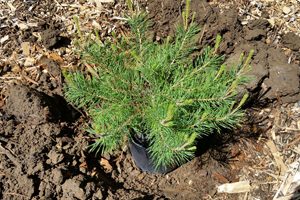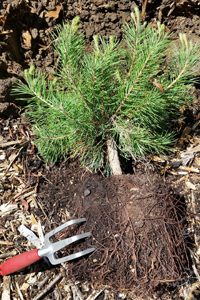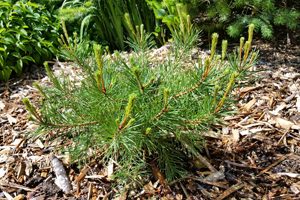We’re often asked by customers if they can plant this time of year, or should they wait for fall. The simple answer- you can plant if you can water. Having said that, it is best not to plant during a real heat wave, when daytime temperatures are in the mid-80’s or higher. Put your plants into a shady area and keep them watered until it cools off a bit.

Hole dug twice as wide as pot
Steps for the act of planting in the summer:
- Water the plant to be planted thoroughly. Let it drain while you prepare the planting site.
- Remove sod and weeds first, then dig your hole. Make the hole twice as wide as the pot, but the same depth.
-

Roots roughed up & ready to plant
Fill the hole with water and let it drain out. Repeat two more times. This wets the soil around the hole.
- Remove the pot from the plant and “rough” the roots. This means rubbing, pulling, tugging, even using a garden claw to pull the roots away from the root mass.
- Place the plant in the hole, making sure it is not too deep. When finished, the surface of the pot should be level with the ground, not below it. If anything, err on the side of planting too shallow, not too deep.
- Fill the hole about 2/3 with soil. Water.
- Fill the hole to the rim with soil. Water again.
- Cover the surface with a mulch. This will help keep the soil moist and cool.

Planted and mulched
For the rest of the summer, water the area enough to keep the soil evenly moist. What does that mean? It means checking at least once a week for soil moisture and water if the soil is not moist to a depth of 6″-8″. It doesn’t need to be wet, just moist.
Why should you plant now, rather than waiting for fall? The first reason- if you can keep the soil moist, by fall the root system of your new plant will be well established. An established plant is hardier going into its first winter. This is especially true for broad-leaved evergreens like rhododendrons or camellias. Any plant that might be a little tender the first winter should definitely be planted before mid-September. This includes figs and most broadleaved evergreens.
Some plants like fruit trees are usually field grown and sold in early spring as bare root plants. By summer your choices of variety and rootstocks gets smaller and smaller. By fall, your choices of variety and rootstock might be quite limited. If you can plant this summer, and keep those trees watered, you’ll be closer to producing fruit.
There is an old Chinese proverb: The best time to plant a tree is 20 years ago. The next best time is now. If you have the time to garden this summer, and the water to keep your plants happy, go for it!

